TechRadar Verdict
The Google Pixel Fold is an excellent, multidimensional handset that feels equally at home as a beefy smartphone or a pint-sized tablet, and it marries that versatility with strong performance and stellar photography. If you think of the Pixel Fold as two devices in one, the high price almost makes sense.
Pros
- +
No-compromises front screen
- +
Excellent construction
- +
Great-looking big screen
- +
Great cameras and photo tricks
Cons
- -
Huge bezel around the tablet screen
- -
Takes a little push to lie flat
- -
The price takes some explaining
Why you can trust TechRadar
Editor's Note
• Original review date: June, 2023
• Pixel Fold has been surprisingly left behind
• Launch price: $1,799 / £1,749
• Lowest price on Amazon (US only): $1,399
Update: April 2024. Google has made many updates to the Pixel phones since the Pixel Fold was launched, but, shockingly, some of the most important new Google features have not come to Google's foldable, even though it's more powerful than other phones that have been updated. Google's new Circle to Search feature, as well as new Gemini AI features, have not been added to the Google Pixel Fold, and Google has given us no timeline when or even if the Pixel Fold will get these updates. Truly a disappointing development in the short life of this pricey phone.

Two-minute preview
The Google Pixel Fold arrives a little late to the foldable party but, based on my time with the device, it's a smartphone/tablet combo that mostly delights, and which is sure to earn a place among our ranking of the best Foldable Phones.
From its construction, including its precision hinge, to its high-resolution screens, the Pixel Fold is a well-thought-out Android phone that's equally at home as a small-screen, but thick, 5.8-inch phone or, unfolded, as a 7.6-inch mini tablet.
The large bezel around the main screen might give pause to some, but it quickly fades into the background, thanks to a responsive, colorful, and multitasking-friendly screen. Even the unavoidable crease down the middle is somewhat less prominent than those on competing foldable phones. And when you fold the Pixel Fold, the two sides meet with nary any visible space between them.
The collection of cameras on board do not disappoint. They can capture lovely landscapes, portraits, macro-like photos (there isn't a dedicated macro mode), astrophotography, and striking long exposures that use image segmentation to blur motion while keeping other aspects of the scene in focus.
I'm particularly pleased that Google put a 5x optical zoom on this phone. Sure, that's half of what you get on the Samsung Galaxy S23 Ultra, but it does beat its closest foldable rival, the Samsung Galaxy Z Fold 4.
Sign up for breaking news, reviews, opinion, top tech deals, and more.

Google has equipped the Pixel Fold with its Tensor G2 chip (the same one that's in its Pixel 7 line), a slightly aging piece of silicon that doesn't beat the competition, but which proved more than powerful enough for every task I threw at it. The Pixel Fold is as at home with web browsing as it is with high-intensity gaming. Plus, the screens' variable refresh rates keep everything looking smooth. A small nitpick might be, well, the lack of nits. The Pixel Fold's main screen is noticeably less bright than the Galaxy Z Fold 4's (the latter boasts more nits), and while I didn't have any issues on cloudy days, it might struggle a bit in direct sunlight.
Naturally, Android 13 (with five years of promised security updates) is perfectly at home on the Pixel Fold, but so are all the Google apps that Google has optimized for the new platform. Mail, Photos, and more work like a charm on the big screen, and there's real joy in being able to drag and drop a photo from another app into an email.
Google arguably stumbles a bit when it comes to the pricing. $1,799 / £1,749 is a lot to pay for a single device, especially as other newcomers, like the smaller but quite impressive Motorola Razr Plus, come in at under $1,000 (Google hasn't announced any plans to release the phone in Australia, but we'll let you know if and when we get official confirmation either way). My take, though is that you're essentially getting two premium devices in one here, and Google is asking you to pay for that.
Overall, I truly enjoyed my time with Google's first folding device. It's not a tentative or compromised first attempt at the form factor: the Google Pixel Fold makes a clean and emphatic landing in the foldable space.
Google Pixel Fold price and availability
- 12GB RAM / 256GB: $1,799 / £1,749
- 12GB RAM / 512GB: $1,919 / £1,869 (Obsidian, only)
Google unveiled the Pixel Fold during its May 10 Google I/0 2023 developer conference keynote, at which it also unveiled its mid-range Google Pixel 7a phone, the Google Pixel Tablet and charging speaker dock, and a ton of new AI technology.
You can preorder the Google Pixel Fold now, with shipping set to commence on June 27, although exactly when you'll be able to get your hands on the phone depends on where you are. The Fold comes in two colors: Porcelain (off-white) and Obsidian (black). My review unit is Obsidian, and I think I prefer it over the white.

If you haven't already, you should disabuse yourself of the notion that when you buy a foldable you're buying one device, and so should pay for one device. The Google Pixel Fold is, like the Samsung Galaxy Z Fold 4, two full-blown devices in one and, as such, it's very nearly worth the $1,799 / £1,749 price tag.
How do I figure this? There are two screens on Google's first foldable, one 5.8 inches and the other 7.6 inches, and each one is large enough to operate as a standalone communication, information, gaming, and entertainment platform.
There are more cameras on the Pixel Fold than on the average handset: three on the back, another one on the external screen, and then one more right above the main display.
If you purchased, say, an iPhone 14 Pro ($999 / £1,099 / AU$1,749) and an iPad mini ($499 / £479 / $749), that would cost you about $1,500, or the UK and Australian equivalents. And naturally, you're paying a premium for more cameras, and that exquisite flexible and hard-to-manufacturer foldable display.
My point is, before you dismiss the Pixel Fold for its hefty price tag, I suggest you consider what you're actually getting for your money, and what this impressive Android 13 smartphone and tablet can do.
Still, at this price, the Pixel Fold is more than a considered purchase, and I fully understand that – especially if you're thinking about the 512GB and nearly $2,000 ($1,919 / £1,869) model – the cost will be a considerable issue.
The good news is that there are already Google Pixel Fold trade-in deals that essentially cut the price of the phone in half. Basically, there should be almost no reason to pay full list price for what is a very impressive device.
- Value score: 4/5
Google Pixel Fold design
- The right form factor for a phone-to-mini-tablet foldable
- Feels solid, if a bit heavy
- Folds completely flat
- Whisper-quiet operation
- Big bezel will distress some
Google's decision to wait out Samsung through four iterations of its foldable devices (and almost five, with the Galaxy Z Fold 5 set to be announced in the next few weeks at the time of writing) turns out to have been a smart move. The Pixel Fold is in many ways what I want all foldables to be.
When folded, its 139.7mm tall by 79.5mm wide by 12.1mm thick frame is like a very thick 5.8-inch smartphone. Unlike the tall and narrow Samsung Galaxy Z Fold 4, the dimensions of which, when folded, stretch the definition of a traditional smartphone display, the Pixel Fold and its front screen could almost pass for a standard smartphone; that is as long as you overlook the flat hinge side, which does not match the curved corners on the opposite side.
Plus, if you don't count the rather prominent camera bump (really a band that runs almost the width of the back of the phone), the Pixel Fold is, at 5.8mm unfolded, slightly thinner than the 6.3mm Galaxy Z Fold.

Even by foldable standards, though, the Pixel Fold is a bit heavy. It weighs 283 grams – that's 20 grams more than the Galaxy Z Fold 4 and, unsurprisingly, 40 grams heavier than Apple's current biggest phone, the iPhone 14 Pro Max.
Again, if you don't appreciate that multi-purpose devices like this are naturally going to be bigger and heavier than standard smartphones, you're barking up the wrong, er, device tree.
This is a premium phone, with high-end materials like a polished aluminum frame, and Corning Gorilla Glass Victus on both the front screen and the back. The hinge is stainless steel and the entire body is IPX8-rated, which means it's ready to survive everything from a storm to an accidental drop in the bath (I didn't submerge the phone but did run it under some water – it survived).
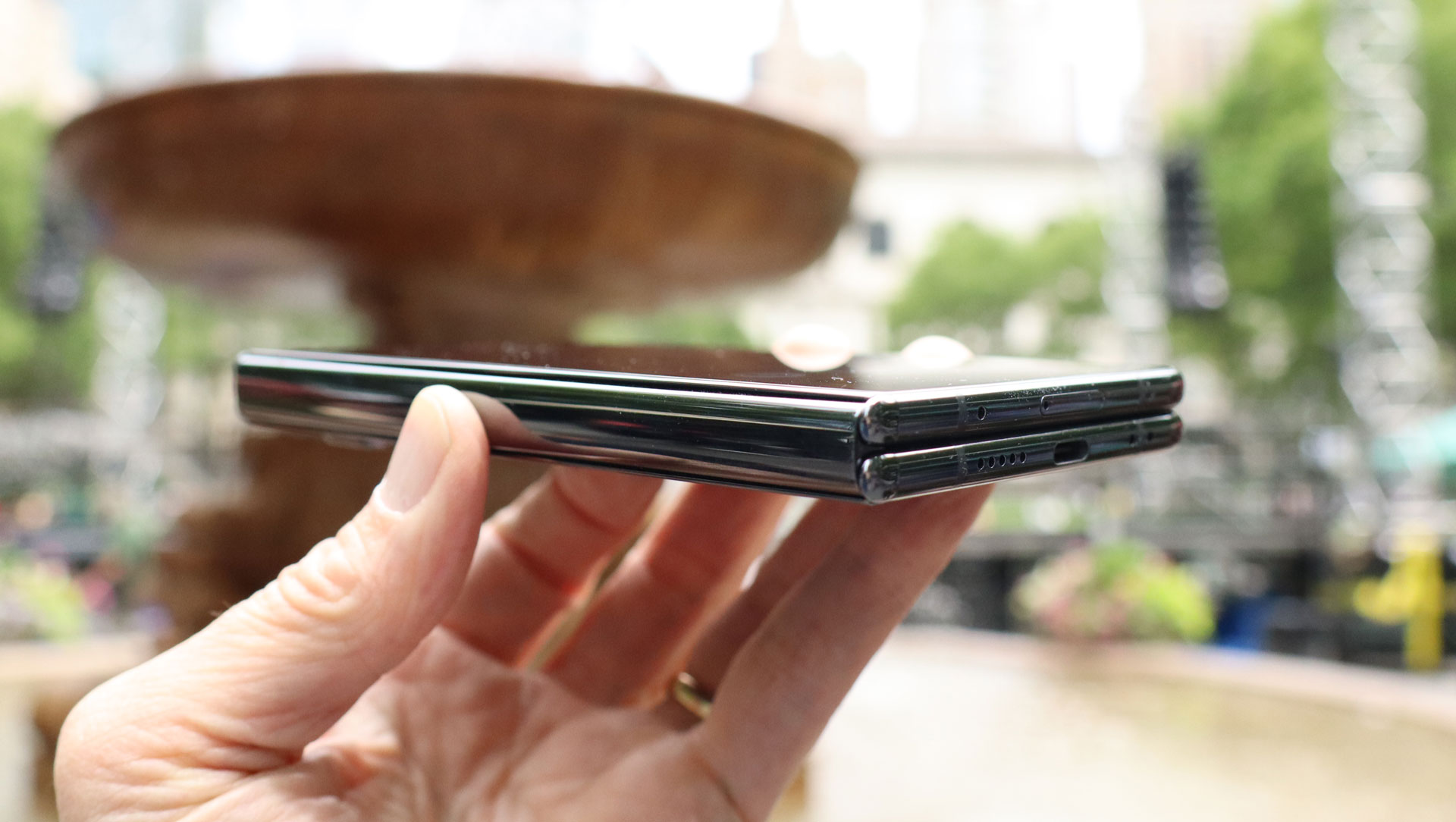
The hinge operation, by the way, is excellent. It's smooth, whisper-quiet (quieter even than the Z Fold 4, which makes a little crinkling sound when you open and close it), and can open to a full 180 degrees or virtually anywhere in between (to support tabletop and Tent operation).
I opened and closed the phone a lot during my testing time, and came away with the distinct impression of long-term durability.
Aside from the rather wide and tall camera bump, there aren't many distinctive features on the outside of the Pixel Fold. On the back, below that bump, is a polished version of Google's distinctive 'G'. The hinge has no markings at all. Opposite the hinge, on the right edge of the phone when it's unfolded, are the phone's two buttons. The power/sleep fingerprint reader (which is effective) is towards the top, and below it is the volume rocker. This is the opposite configuration to the Samsung Galaxy Z Fold 4 and, it took some getting used to – I kept pressing the power button when I meant to adjust the volume, although I'm sure that if I spend enough time with the Pixel Fold, hitting the right button will become second nature.
There are microphone and speaker grilles along the top and bottom edges of the phone. Along the bottom is the USB-C charging port (the foldable ships with a cable and even a USB-3-USB-C adapter, but no charging adapter – it feels like something that should be included at this price). There's also a physical SIM slot, though the Pixel Fold does support dual SIM and eSIM, too.

A few things stand out when I unfold the Google Pixel Fold. One is that, unless you give it an extra press down on each side, the phone does not automatically unfold completely flat, although this isn't a big deal, as it's very easy to nudge it to an essentially flat plain. I remain somewhat surprised by the size of the bezel surrounding the Fold's flexible main screen. In contrast to the bezel on the Galaxy Z Fold 4 it's huge; however, once you start using this display, it quickly fades into the background.
There is a reason for the big bezel: it houses the main screen's 9MP camera. On the Galaxy Z Fold 4, Samsung chose to put a punch hole in the screen, and maybe that was the right call for a slightly large folding screen – I'm not sure.
As I mentioned earlier, the power button doubles as an effective fingerprint reader, and there's another biometric security option: you can register your face and unlock it with the Cover screen's camera. Oddly, though, you can't unfold the Pixel Fold and use that screen's camera to unlock with your face; it's a small but annoying omission on Google's part.
- Design score: 4.5/5
Google Pixel Fold displays
- 5.8-inch external screen with a normal aspect ratio
- Lovely, large flexible display that's a good fit for all activities
- A slightly diminished crease
- 120Hz variable refresh rate on both screens

One of the best things about Pixel Fold's two screens is that there is zero trade-off between using just the outer cover screen or the expansive main display.
I love that Google went with a full-width 5.8-inch cover display. That's considerably shorter than the Galaxy Z Fold 4's 6.2-inch external display, but it's also almost a half-inch wider – and I can say without reservation that I prefer the Pixel Fold's wider external screen. Not only is it easier to navigate, but apps like Instagram and TikTok look a lot better on it. The difference in size is better illustrated when you look at the resolutions – where the Galaxy Z Fold 4's cover display is 2316 x 904 pixels, the Pixel Fold's OLED is 2092 x 1080.
It's a pleasingly bright screen both indoors and out, with a promised 1,200 nits of brightness in typical use (the peak brightness is 1,550 nits), and smooth in operation thanks to an adaptive refresh rate (60Hz to 120Hz). I also like that there's an always-on display option (you have to dig into the settings to find it as it's not set up by default).
Overall, the cover screen is the display you'll most often use when on the go. It's the perfect viewfinder for the main camera array on the back, and the size is, depending on your hand, basically palm-friendly.

Of course, there's a reason you're carrying around all that weight and girth: the large main screen. Unfolded, this is a 7.6-inch tablet-like display covered in ultra-thin flexible glass and a layer of protective plastic. At 2208 x 1840 it's got just a touch more pixels/resolution than the Galaxy Z Fold 4's main screen.
I grew to love this screen. Apps like Google Maps, Netflix, and YouTube, and games like Asphalt 9: Legends, and Call of Duty Mobile look fantastic on it. If you happen to start playing Call of Duty on the big screen, then close the Pixel Fold and try to continue on the cover screen, you may notice that the image is distorted. I was able to fix this by closing the game and restarting on the cover screen – it seems like a a bug that Google could fix with a software update.
In a side-by-side comparison, I did find that the Galaxy Z Fold 4's main screen is a little brighter. It's worth noting that the Pixel Fold's main display does not even match the brightness of the cover display; it's 1,000 nits as standard, with a peak brightness of 1,450 nits. Still, this is something you'd only notice if you had the two phones and screens side-by-side (as I did).
Like the cover display, the main screen supports an adaptive refresh rate of up to 120Hz. It has the same 1,000,000:1 contrast ratio, supports 16 million colors, and offers HDR support (though not HDR10+). it also supports the always-on display.
This being a foldable display, there is a crease that you can both see and feel, but it disappears when you're using apps, playing games, and watching videos. I did notice that this crease is ever so slightly less prominent than the seam on the Samsung Galaxy Z Fold 4's main screen.

Google makes good use of the cover display, and of the device's folding capabilities. If I fold the phone to roughly 45 degrees and set it up like a tent, I can watch Netflix as a full-screen experience on the cover display. If I unfold the Pixel Fold, the show or movie is automatically switched to the main screen.
I did notice that YouTube is not entirely optimized for the Pixel Fold – when I tried to play a YouTube video in Tent mode, it insisted on playing upside down.

The main screen also has a couple of nifty mid-fold tricks up its sleeve. I can bend it 90 degrees and set the Pixel Fold up in Tabletop mode. With it, I can watch movies, take a selfie, capture perfectly still time-lapse videos, or, as I did on more than one occasion, conduct hands-free Google Meet video meetings. Try doing that with your regular phone and no tripod.
You can also bend the phone a bit further so the main cameras are pointed and the sky and collect tripod-free night photography.
A big screen also means that I have space for not just one, but two apps. The Pixel Fold is a good multitasker that makes running two apps easy. All I have to do is open one app, like Chrome, then sweep up from the bottom to access the app dock, hold down on a second app like the Camera, and then drag it to the left or right side of the screen. You can resize the split of the two screens but, unfortunately, cannot run a third app. Still, it is useful to be able to have a map open at the same time as your camera viewfinder, especially if you're hiking and want to capture great shots while not getting lost.

- Display score: 4.5/5
Google Pixel Fold cameras
- Overall excellent cameras
- Backed by powerful Google tools
- Long exposure mode is a delight

Google has been widely praised for the cameras on its Pixel phones, and I think the Pixel Fold also earns those accolades.
Its cameras not only take excellent photos across a wide range of styles, they're complemented by some of the most powerful on-board image-processing magic in the business. I haven't had this much fun using a smartphone's cameras in quite a while.
It's not just the camera app, or the editing I can do post-shot; the entire suite of camera hardware is strong. And while the Pixel Fold doesn't beat the Samsung Galaxy Z Fold 4 in every aspect, I don't think anyone will feel cheated by any single lens.
Here’s the full list of cameras:
- 48MP f/1.7 wide (rear)
- 10.8MP ultra-wide f/2.2, 121-degree field of view (rear)
- 10.8MP telephoto 5x optical f/3.05 (rear)
- 9.5MP f/2.2 (cover)
- 8MP f/2.0 (above main screen)

By and large, this array matches up pretty well with what's on the Samsung Galaxy Z Fold 4. The biggest difference is probably the Pixel Fold's main display camera, which has double the megapixels of the Z Fold 4's.
What I really appreciate though is the 5x optical zoom (you get just 3x on the Z Fold 4). I love a good optical zoom. Yes, both devices offer their own form of digitally- and AI-enhanced zoom. The Pixel Fold's Super Res Zoom (up to 20x) is sort of impressive, but as with most of these digital implementations, the images kind of fall apart if you look too closely. Still, I love having an optical image stabilized (OIS) and electronic image stabilized (EIS) 5x zoom in my pocket.
As you can see from my photo gallery further down the page, the Pixel Fold not only takes sharp and bright images, it also maintains excellent color fidelity. These images all look impressively like the real-world subject; nothing is oversaturated beyond nature's creation. The cameras let you capture subjects from a distance, and also allow you to get up close and personal, courtesy of the Fold's approximation of macro photography. To be clear, I can't really get closer than, say six or seven inches, but the effect is like macro, with a blurred background and a tight, sharp focus on the nearby object (see my yellow flowers).
There are a number of cool onboard tricks that can improve your not-so-awesome photos. Photo Unblur can sharpen photos blurred by your wobbly hands (although the camera is fast enough that I had to work to make a blurry photo for my tests). Magic Eraser is here, and it let me easily select and remove a bunch of commuters from one of my photos, as you can see below. The process of selection and removal is not instantaneous – it's like the Pixel Fold wants to show you how hard it's working.
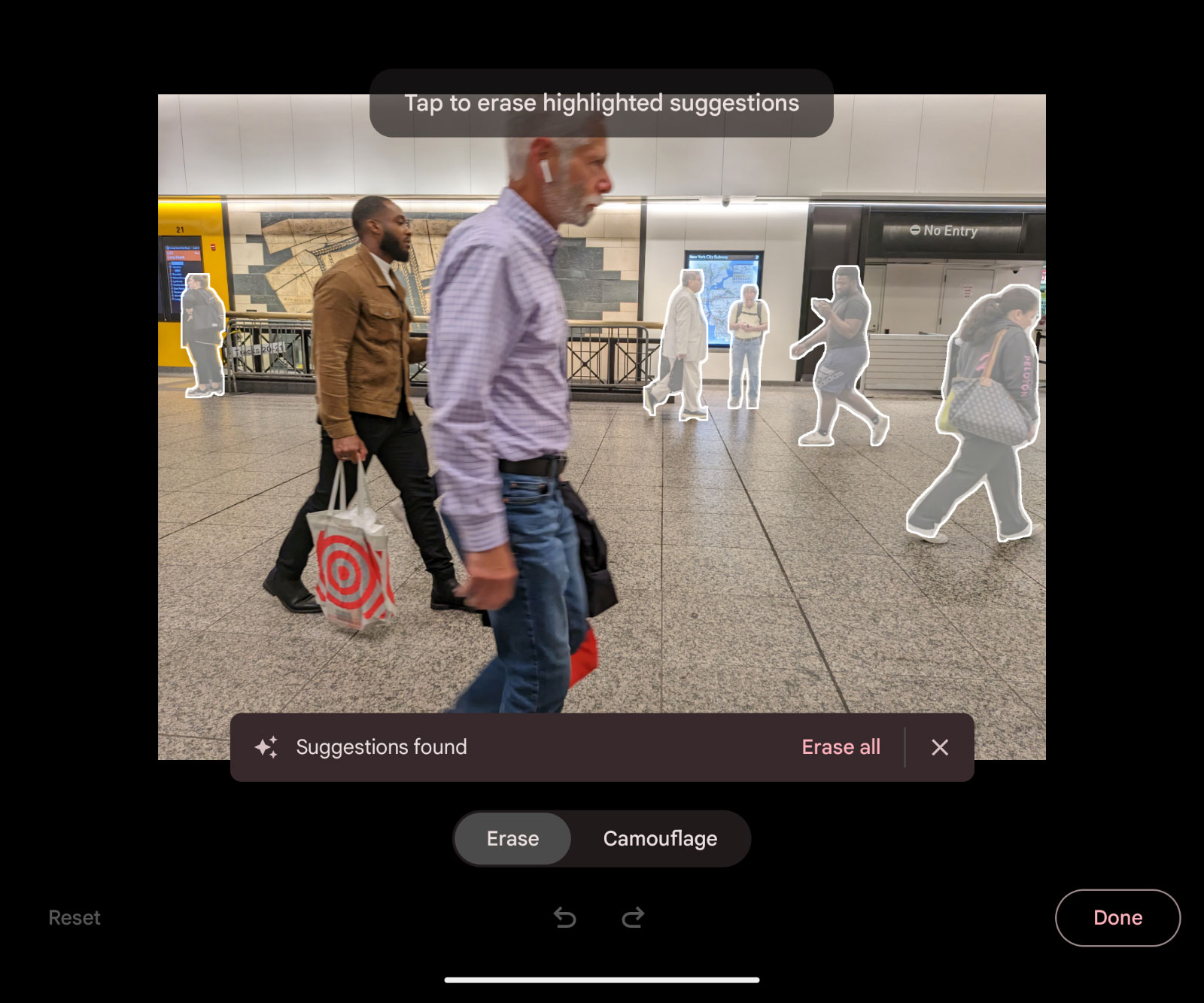

My other favorite feature in the Camera app is Long Exposure. This is not night photography. Instead, it's a much shorter-term exposure that captures some movement while leaving the rest of the photo sharp. When I took a photo of a flowing brook using this setting (the on-screen instructions ask you to hold still for a second), it kept the surrounding rocks in focus while blurring the flowing water. It did the same thing with my fountain shot: the water is blurred, but the fountain and surrounding detail are sharp. I tried it in the train station, and it turned rushing commuters into streaks while, in the background, a man who stood still was clear as day. Again, the process of creating these effects takes a moment, and I wonder if a newer Tensor chip (the G2 is almost a year old, after all), might make quicker work of these operations.



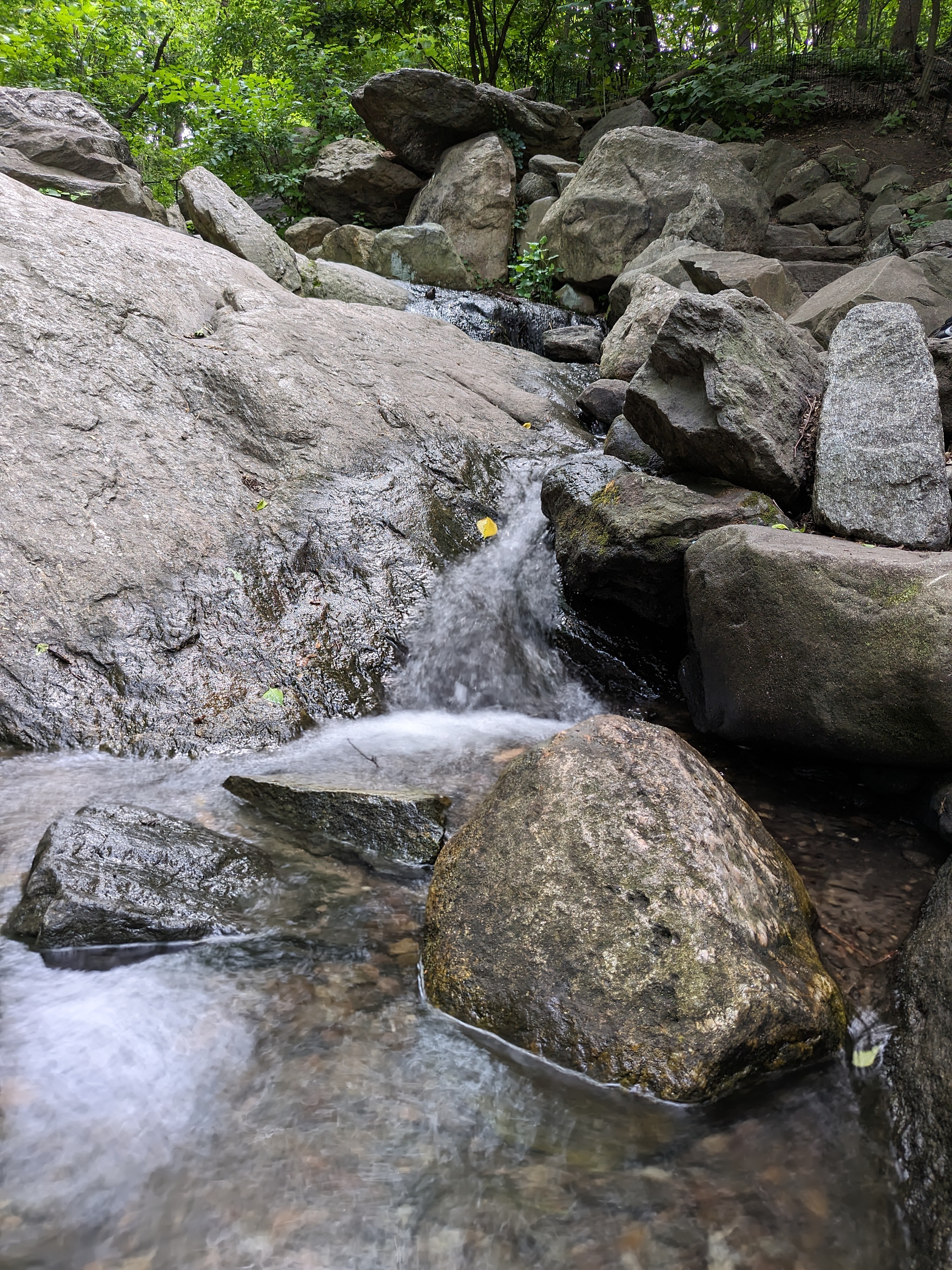

You can shoot a selfie, even in portrait mode, with the 9MP inside camera or the 8MP one on the cover screen, but Google also makes it possible to shoot selfies with the Pixel Fold's best camera.
First, you unfold the device and then open the Camera app. Below the 'switch camera' icon is an option that lets you switch camera display screens. Once you do that, the cover screen becomes the camera viewfinder and, because the Pixel Fold is open, you're staring at the rear camera array. It's not the smoothest process, and it's basically impossible to hold the device this way with just one hand and take the shot, unless you add one more step and set up the gesture-activated timer mode.
To do so, I had to set the timer for three seconds, and then hold up one hand until a yellow box appeared on screen around it, which initiated the timer. I could then lower my hand, and the Pixel Fold would take a perfect selfie.
Complicated? Sure. Useful? Absolutely.
Virtually all flagship phones offer some form of astrophotography, and the Pixel Fold is no different; however the double act of Nightscape photography and Tabletop mode is something special. I was able to set up the phone with the screen folded but not fully closed, so the main camera was pointed at the night sky, and then fiddle with the on-screen settings to get a perfectly still starscape, without the need to hold the phone and try to stand still for six seconds, or use a tripod.
The shot below was taken with the 5x optical zoom and a six-second exposure.

- Camera score: 4.5/5
Camera samples




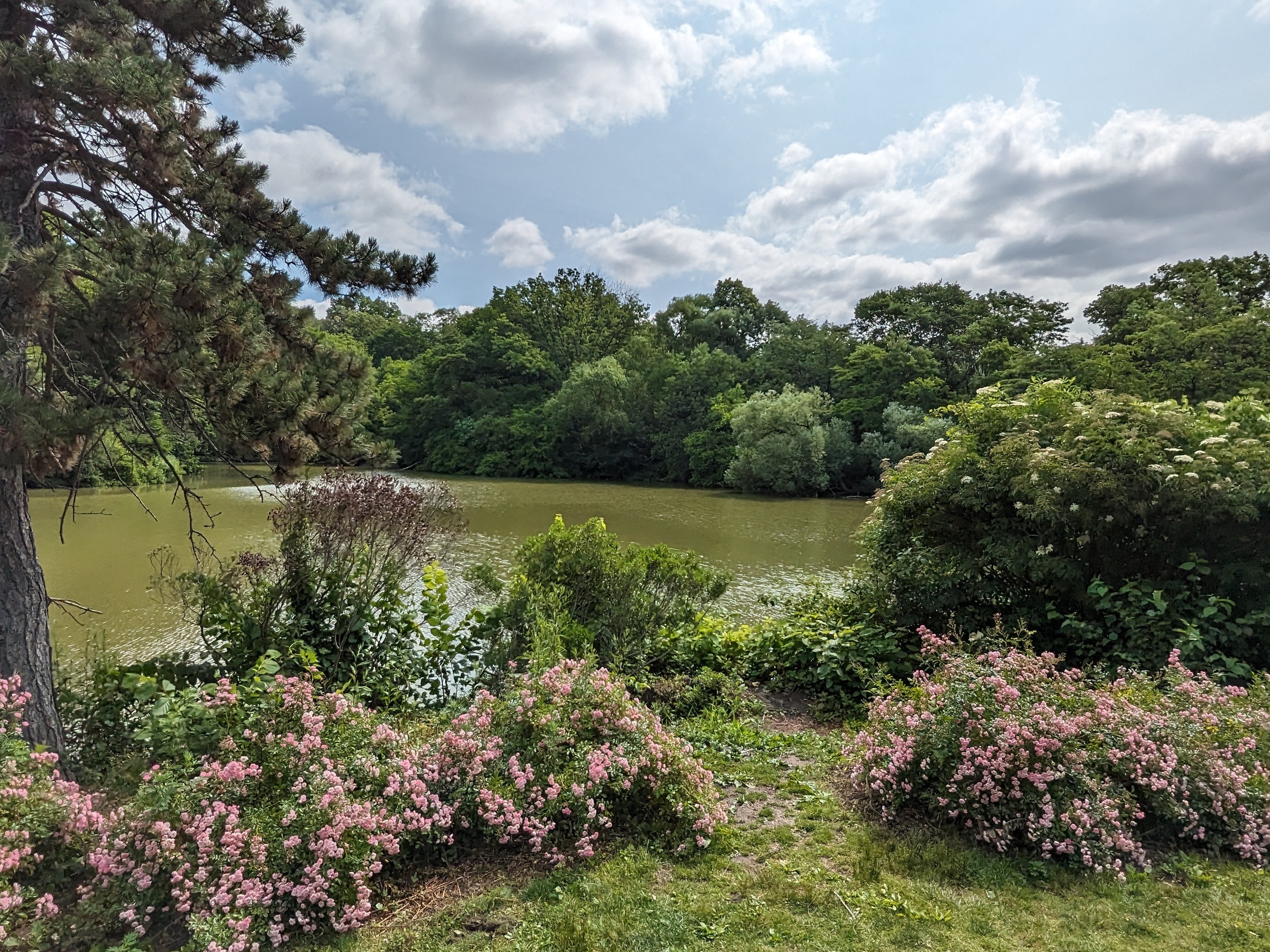






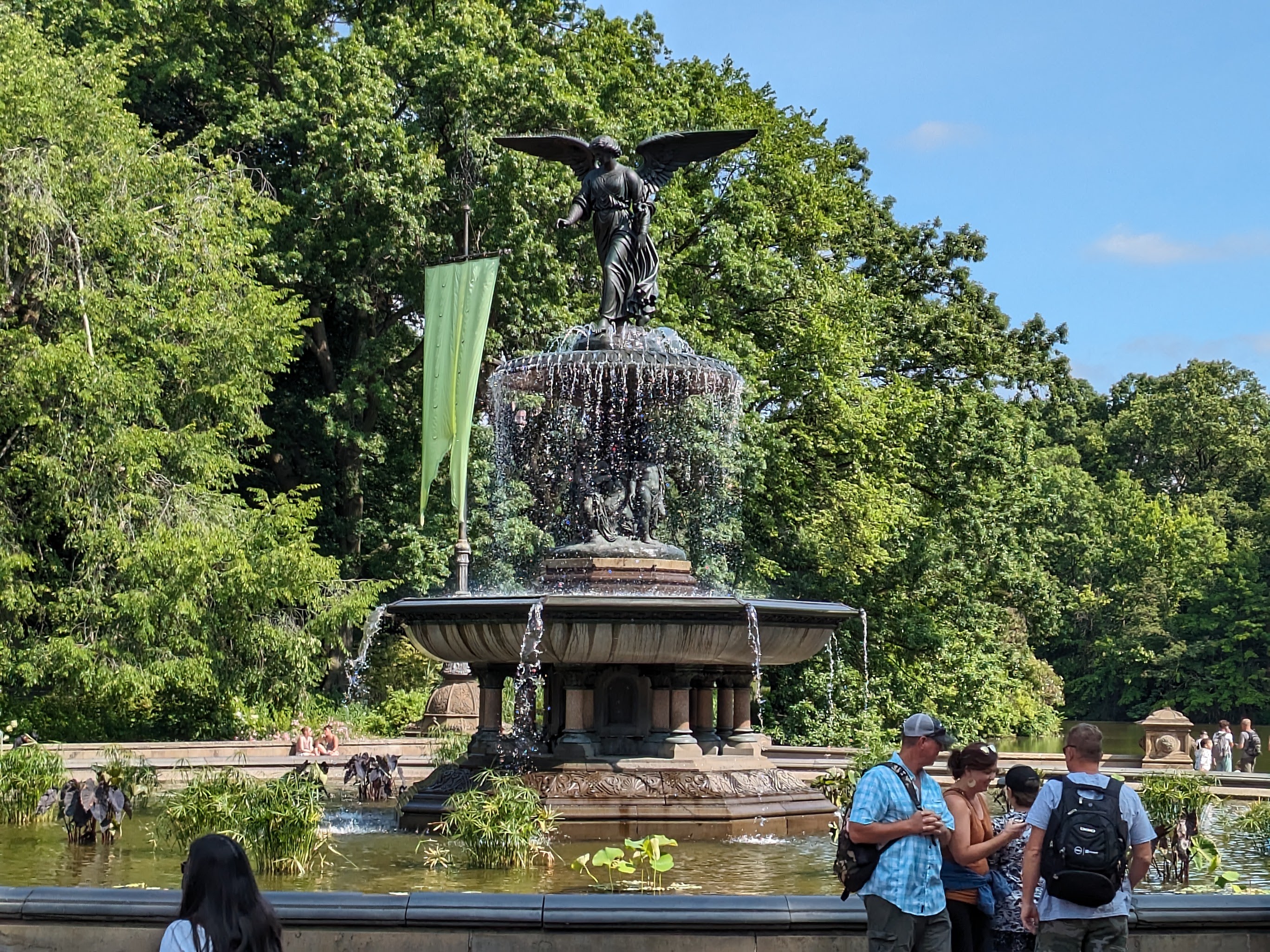






Google Pixel Fold performance and specs
- Packs Google's aging Tensor G2 chip
- Perhaps a step behind the latest Qualcomm Snapdragon
- 12GB of RAM, starts at 256GB of storage
Inside the Google Pixel Fold is the zippy Google Tensor G2, the same chip that powers the Google Pixel 7. This is a capable and powerful mobile CPU, although with a Tensor G3 expected in a few months (maybe in the Pixel 8) we have to wonder why Google's first foldable didn't get what's set be Google's most cutting-edge silicon.
In general, though, there's almost no evidence that the chip is slowing anything down. Every game, app, and web operation I performed was smooth and instantaneous. Photo-editing operations and tricks like Long Exposure took a beat to render, though. Perhaps that's down to the G2, or maybe that's how long the likes of Magic Eraser and Long Exposure would take on any mobile platform.

Google pairs the Tensor G2 with a healthy 12GB RAM and its Titan M2 security coprocessor.
Benchmark scores put the Pixel Fold slightly behind the Galaxy Z Fold 4 and its Qualcomm Snapdragon 8+ Gen 1, while gaming benchmarks, specifically the ones that look at frames per second, put it somewhat behind Qualcomm's latest chips. However, in my gameplay experience across Asphalt 9: Legends and Call of Duty Mobile, I didn't notice a difference. There was no stuttering or tearing, and everything looked great and was highly responsive, so much so that I was MVP during my first round of Call of Duty.
This is also a 5G phone, though without a test SIM I wasn't able to test its cellular operations. It also supports WiFi 6e, which means I had fast and reliable connections at home and in the office.
As for audio performance, there are stereo speakers that can go pretty loud – and immersive, thanks to spatial audio support – without any distortion. The three microphones, meanwhile, are so sensitive that when I barely whispered "Hey, Google…" the phone heard me and awaited my instructions.
| Google Pixel Fold | Samsung Galaxy Z Fold 4 | Oppo Find N2 Flip specs | |
|---|---|---|---|
| Dimensions (folded): | 139.7 x 79.5 x 12.1mm | 155.1 x 67.1 x 15.8mm | 85.5 x 75.2 x 16.02mm |
| Dimensions (unfolded): | 139.7 x 158.7 x 5.8mm | 130.1 x 155.1 x 6.33mm | 166.2 x 75.2 x 7.45mm |
| Weight: | 283g | 263g | 191g |
| Main display: | 7.6 inch (2208 x 1840) OLED | 7.6 inch (2176 x 1812) AMOLED | 6.8-inch 21:9 (2520 x 1080) 120Hz LTPO E6 AMOLED, protected by UTG |
| Cover display:: | 5.8 inches (2092 x 1080) OLED | 6.2 inches (2316 x 904) AMOLED | 3.26-inch 17:9 (720 x 382) 60Hz AMOLED, protected by Gorilla Glass 5 |
| Chipset: | Google Tensor G2 | Qualcomm's Snapdragon 8 Plus Gen 1 | MediaTek Dimensity 9000 Plus |
| RAM: | 12GB (LPDDR 5) | 12GB | 8GB (LPDDR5) |
| Storage: | 256GB / 512GB | 256GB / 256GB / 1TB | 256GB (UFS 3.1) |
| OS: | Android 13 | Android 13 | Android 13 w/ ColorOS 13 |
| Primary camera: | 48MP, f/1.7 | 50MP f/2.2 | 50MP, f/1.8, 23mm, 86° FoV (Sony IMX890) |
| Ultrawide camera: | 10.8MP, f/2.2 | 12MP f/2.2 | 8MP, f/2.2, 16mm, 112° FoV (Sony IMX355) |
| Telephoto | 10.8MP f/3.05 | 10MP f/2.4 | |
| Front Camera: | 9.5MP f/2.2 | 10MP f/2.2 | 32MP, f/2.4, 21mm, 90° FoV (Sony IMX709) |
| Inner Camera | 8MP f/2.0 | 4MP f/1.8 | |
| Battery: | 4,727mAh | 4,400mAh | 4,300mAh |
| Charging: | 30W (wired) | 25W (wired) | 44W (wired) |
| Colors: | Porcelain, Obsidian | Gray, Phantom Black, and Beige | Astral Black, Moonlit Purple |
- Performance score: 4.5/5
Google Pixel Fold software
- Android 13
- Google knows how to fold
- Seamless multitasking



What matters here, though, is not the speeds and feeds of this phone but, for me at least, how Google's first foldable uses Android 13, and the Fold's small outside and big inside screens, to maximum effect.
Many of Google's core apps, like Maps, Gmail, Photos, Home, and Drive, have been redesigned for the folding-screen environment (as have some third-party ones like Netflix). Mail, for instance, converts from a single-column experience on the cover screen to a dual column on the main screen that puts your mail list on the left and opens each email in a pane on the right. It's all smart and, honestly, what you would expect.
Multitasking is a strong suit here. As I mentioned, it's easy to drag and drop one app to open alongside another on the main screen, although I do wish I could add a third app on top of those two.
When you have two apps open side-by-side you can drag and drop between them. I opened Gmail and Google Photos, and to add a photo to an email I was composing I simply tapped and held my finger on the image until a little thumbnail appeared, then dragged it over to the compose screen on the left. Nothing could be easier.
The best way to describe my overall experience with the Google Pixel Fold software environment is that it was pleasant surprise. Everything looks so good, and works so well together.
- Software score: 4.5/5
Google Pixel Fold battery life
- 4,727mAh
- Laster 15 hours
- Supply your own charging adapter

I did what I could to stress-test the Pixel Fold's ample 4,727mAh battery, pushing screen brightness to max, not letting the screen sleep before 30 minutes had elapsed, and playing action games, watching videos, browsing the web and holding multiple, lengthy video conference calls (colleagues said I sounded good, but looked a little less sharp than I normally do through my MacBook Air (M2) FaceTime camera).
After wirelessly charging the Pixel Fold on my Qi charging base, I grabbed the phone at 7am and used it almost continuously until 10pm when it ran out of juice. I did not, when it prompted me at 10% battery life, let it switch to Extreme Battery Saver mode because that would have paused my apps.
- Battery score: 4.5/5
Google Pixel Fold score card
| Attributes | Notes | Rating |
|---|---|---|
| Design | Google may have found the sweet spot for tablet-sized foldables | 4.5/5 |
| Display | Cover display is shorter than the Galaxy Z Fold 4, but more than makes up for it in width. The main screen is beautiful and the big bezel quickly fades into the background. | 4/5 |
| Performance | The Tensor g2 has more than enough performance to satisfy most foldable needs | 5/5 |
| Camera | An excellent colleciton of cameras inside and out that take beautiful photos | 4/5 |
| Battery | Battery life is solid | 3.5/5 |
| Software | Android 13 seems perfectly at home on this dual-display, dual-mode device. | 4/5 |
| Value | It's costly but such is the price of two premium devices in one. | 4/5 |
Should I buy the Google Pixel Fold?
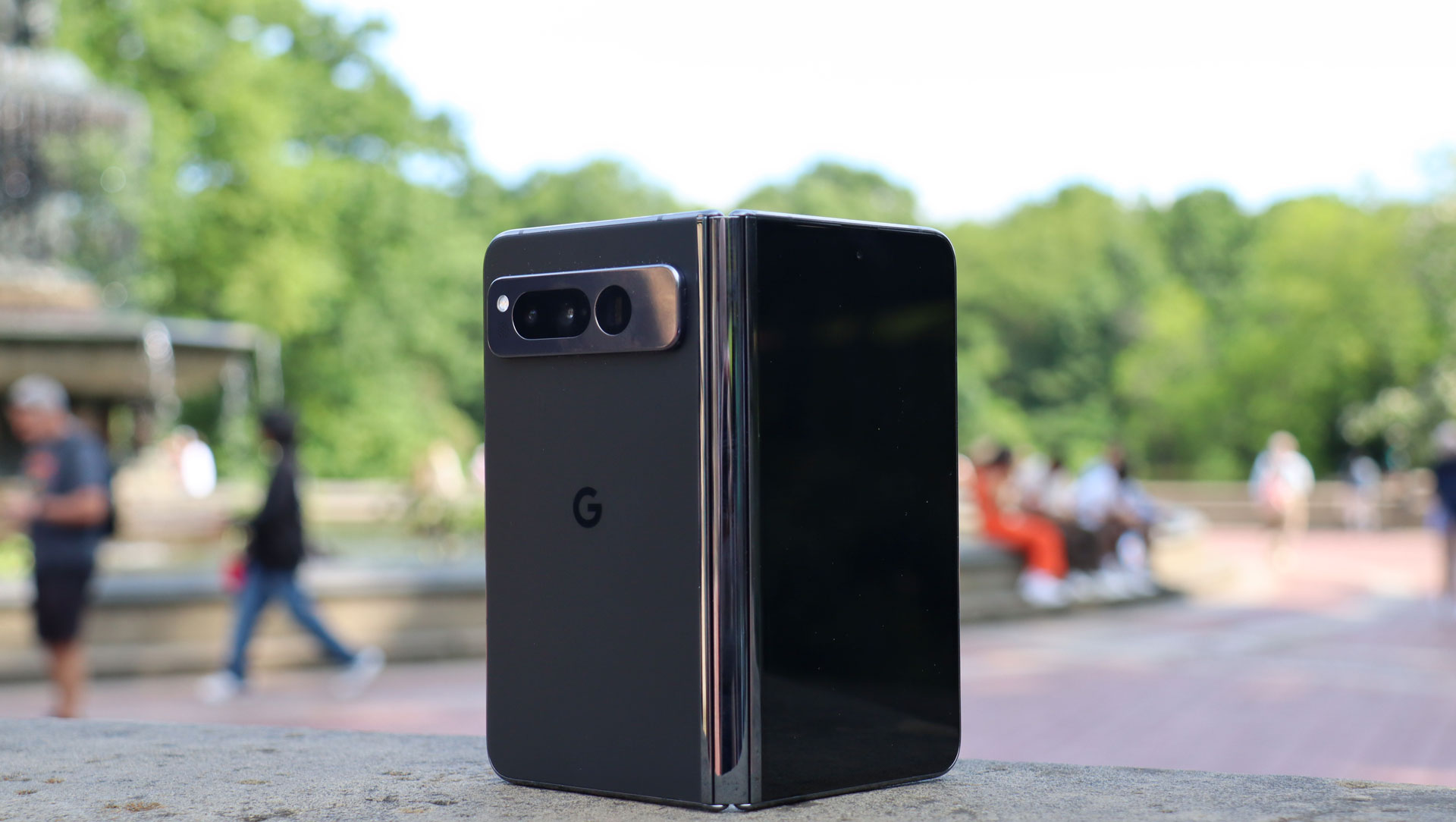
Buy it if...
You want two devices in one
The Pixel Fold is an able phone, and a fun and productivity-enhancing tablet.
You care about photography
You get an excellent collection of cameras backed up by some truly useful software and AI tricks.
You want a full-sized foldable
There are smaller, cheaper foldables, but if you want a main screen that opens to tablet size you should look at the Pixel Fold.
Don't buy it if...
Money is tight
Google has ably combined two devices into one – and it's charging you for both. It's a hefty investment, so if you must have the Pixel Fold, hunt down one of the generous trade-in deals that's available.
You want bleeding-edge components
Google's Tensor G2 is plenty fast, but there might be a G3 just around the corner. Could this handset have benefited from newer silicon?
You want a thin and light phone
Folded, the Pixel Fold is fat, and it's also kind of heavy.
Google Pixel Fold review: also consider
| Google Pixel Fold | Samsung Galaxy Z Fold 4 | Motorola Razr Plus | |
|---|---|---|---|
| Price: | $1,799 / £1,749 | $1,799 / £1,649 / AU$2,499 | $999.99 / £1,049.99 / AU$1,499 |
| Display | 7.6-inch internal; 5.9-inch external | 7.6-inch internal; 6.2-inch external | 6.9-inch internal; 3.6-inch external |
| Cameras | 48MP f/1.7 wide (Rear) 10.8MP ultra-wide f/2.2 with 121-degree fov (Rear) 10.8MP telephoto 5x optical f/3.05 (Rear) 9.5MP f/2.2 (Cover) 8MP f/2.0 (Above main screen) | 12MP ultrawide with 123-degree field of vision F2.2 50MP Wide F1.8 10MP telephoto F2.4 Cover: 10 MP F.2.2 Main screen: 4MP F1.8 | 12MP (f/1.5, 1.4μm); 13MP (f/2.2, 1.12μm), 32MP (f/2.4, 0.7μm) (binned: 8MP, 1.4um) |
| Battery | 4,727mAh | 4,400mAh | 3,800mAh |
Samsung Galaxy Z Fold 4
The Galaxy Z Fold 4 is a do-everything device that presents few compromises, and it's great for photography, multitasking, and watching Netflix. However, the high price might put off some potential buyers.
Read our full Samsung Galaxy Z Fold 4 review
Motorola Razr Plus
The Motorola Razr Plus / Razr 40 Ultra is a major evolutionary step for smartphones, going beyond what any previous flip or foldable phone has offered.
Read our full Motorola Razr Plus
How I tested the Google Pixel Fold
I embarked on an entertaining walking tour through New York's Central Park with a test device, during which I took lots of photos, and carried out an additional five days of testing with my Google-provided Pixel Fold test unit.
I carried the Fold with me every day, and used it as often as possible, including on the train, where I tethered it to my iPhone 14 Pro. I shot photos in a variety of environments and situations, and edited the photos with available tools on the device.
While I spent a lot of time using productivity and information apps on the Pixel Fold, I have to admit that I spent an almost equal amount of time playing games and watching videos. It's just such a fun device to use – there's nothing like having a tablet hidden in your pocket.
We ran GeekBench 6 and other benchmarks on the phone at Future Labs, and I combined that information with my anecdotal performance results.
First reviewed June 2023

A 38-year industry veteran and award-winning journalist, Lance has covered technology since PCs were the size of suitcases and “on line” meant “waiting.” He’s a former Lifewire Editor-in-Chief, Mashable Editor-in-Chief, and, before that, Editor in Chief of PCMag.com and Senior Vice President of Content for Ziff Davis, Inc. He also wrote a popular, weekly tech column for Medium called The Upgrade.
Lance Ulanoff makes frequent appearances on national, international, and local news programs including Live with Kelly and Mark, the Today Show, Good Morning America, CNBC, CNN, and the BBC.


